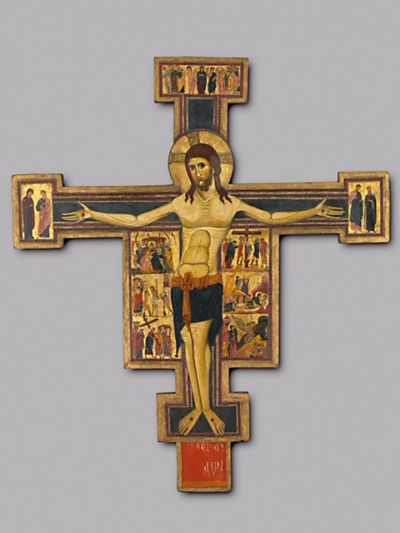The cross is one of the oldest and most universal of all symbols. It is the central image in Christian art, the unique symbol of Christ himself because of his Crucifixion. In a broader sense, the cross has become the mark or sign of the Christian religion and in the eyes of Christians, the emblem of atonement and the symbol of salvation and redemption through the Christian faith. The crucifix, essentially a cross showing the body of Christ affixed to it, would have been a common sight in medieval Europe. Crucifixes were made from many materials including wood, bronze, ivory, and enamel. Their scale also varied from something small enough to fit into the palm of the hand to versions that were much larger. In medieval churches, crucifixes were either placed upon the altar or else suspended above it. There, they symbolized the continued sacrifice of Christ on the cross through the consecration of the Eucharistic bread and wine which took place during each Mass. The death of Christ on the cross is the visual focus of Christian contemplation and above each altar the crucifix afforded the faithful the opportunity to contemplate Christ’s Passion.
It is clear from examples that survive from the Middle Ages and early Renaissance that the crucifix, in the hands of a great artist, achieved the status of a consummate work of art. The Cleveland Museum of Art possesses a beautiful example of a large-scale, painted crucifix made in Pisa during the 1230s. The cross is more than six-feet-tall. Painted crucifixes were a distinct Italian tradition and represent the earliest panel paintings to survive from medieval Italy. Such crucifixes were once placed in nearly every church in Italy as well as many smaller chapels and remained popular until about 1350. It is still possible to see painted crucifixes suspended over some altars in Italian churches, such as Santa Croce in Florence.
The majestic Cleveland crucifix is one of the few elaborately painted Italian crosses in the U.S. It shows Christ alive on the cross, a triumphant savior. This way of depicting Christ was abandoned around 1250 in favor of showing him suffering with tears flowing down his face and his emaciated body sagging, a version that emphasized his humanity. On our Pisan cross, Christ appears triumphantly alive in a way that foreshadows his Resurrection. In addition to the figure of Christ, the Cleveland cross contains six smaller scenes of the Passion, the events surrounding Christ’s crucifixion. These highly detailed subsidiary scenes appear on the cross’s “apron” and are typically found only on early crucifixes made before the mid-1200s.
The story of the Passion begins in the apron’s upper left with the Arrest and Judas betraying Christ with a kiss. The narrative then proceeds downward with the Flagellation and Christ Carrying the Cross. The next event is the Crucifixion itself represented by the large corpus of Christ. He is mourned in the left terminal by the Virgin and St. John the Evangelist and in the right by St. James the Greater and St. Bona of Pisa. The unusual appearance of St. Bona, the patroness of the city of Pisa, suggests that the cross may have been made for the church of San Martino in Pisa where Franciscan nuns tended and prayed over the holy woman’s relics. The story on the apron continues down the right side with the Descent from the Cross, the Lamentation and the Three Maries discovering the Empty Tomb. The conclusion, the Ascension of Christ, once appeared in a pinnacle above the upper terminal showing the Virgin and Apostles gazing heavenwards. The artist of the Crucifix signed the work in large bold letters in the lower terminal. Some of these letters have been lost over time, however, the signature that survives may read “Michele son of … vini painted this.” So while we believe the artist was named Michele, only the ending of his family name remains.
Although the identity of the artist who painted the crucifix remains somewhat of a mystery, its style and format confirm that it was produced in the city of Pisa. The city was at the time a major center of culture and trade. From about 1000 until its defeat by Genoa in 1284, Pisa was one of the most powerful cities in the Mediterranean. Pisa’s famous campanile or “leaning tower,” as well as its cathedral and baptistery were all under construction at the time the Cleveland cross was being painted.
Pisa’s strategic importance as a commercial center and its trade links with Constantinople in the Byzantine East, meant that Pisan artists could have easily been exposed to the Byzantine tradition of icon painting. Moreover, it would have not been unusual for Byzantine artists and painters to have had some presence in Pisa, thus influencing local painters. The head of Christ on Cleveland’s Crucifix, especially the uninterrupted flowing lines of the hair and beard, is descended directly from highly stylized Byzantine icons. Despite these influences, other aspects of the painting remain Italian, most notably in the apron’s scenes and their attempt to capture the drama and emotion of sacred stories. The emphasis on pathos ultimately came to characterize monumental Italian crucifixes.
From the 1250s onwards, Italian artists abandoned apron scenes on painted crucifixes in favor of geometrically patterned grounds, thus focusing the viewer’s attention entirely upon Christ. The painted crucifix now in the Cleveland Museum of Art, though beautifully preserved and elaborate in its detail, was probably one of the last of its particular kind.



